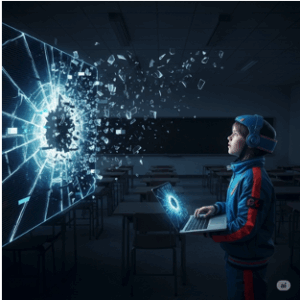“We must ask ourselves why the reduction of DOE personnel, moving services to other federal agencies, or the potential elimination of the department matter for K-12 distance learning programs?” suggests Rebecca J. Blankenship, Ph.D.

 Distance education has become a learning modality staple in K-12 education in United States public schools. Virtual learning and online instruction have become vital parts of current teaching and learning, almost synonymous with what is considered part of a modern education experience. However, with the potential shuttering of the Department of Education, there are many questions surrounding the short- and long-term impacts on how distance learning will be delivered, funded, and regulated. Here, we discuss the urgency to begin a dialogue about the potential positive and negative implications of distance learning without the DOE, as we grapple with virtual futures now on ambiguous foundations.
Distance education has become a learning modality staple in K-12 education in United States public schools. Virtual learning and online instruction have become vital parts of current teaching and learning, almost synonymous with what is considered part of a modern education experience. However, with the potential shuttering of the Department of Education, there are many questions surrounding the short- and long-term impacts on how distance learning will be delivered, funded, and regulated. Here, we discuss the urgency to begin a dialogue about the potential positive and negative implications of distance learning without the DOE, as we grapple with virtual futures now on ambiguous foundations.
During the 2024 presidential race, then-candidate Donald Trump campaigned on the pledge to eliminate the federal Department of Education and return control of our nation’s K-12 public schools back to state governments and local school districts. His pledge was met with significant backlash from teachers, teacher’s unions, and state legislators, who were concerned that decentralizing public education would have negative long-term implications in multiple areas, ranging from funding to specialized student services.
In the first 100 days of the Trump presidency, the legal challenges to his executive orders to begin dismantling the Department of Education entered the federal court system, with multiple plaintiffs contending that program cuts and personnel reductions would have a substantial and systemic negative impact on district budgets, teacher quality and retention, and student learning outcomes. One such legal challenge related to personnel reduction was eventually appealed to the United States Supreme Court (SCOTUS).
 On July 14, SCOTUS sided with the Trump administration in its proposal to begin dismantling the Department of Education. In a decisive 6-3 decision, the Court ruled that plans to discharge as many as 1,500 DOE employees were within the privileges of the Executive Branch as part of its constitutional authority to manage its 15 administrative agencies. While the President does not have the unilateral constitutional mandate to completely shutter the DOE (this would need Congressional action under separation of powers), he is granted the authority to manage its operational structure, shape educational policies through executive orders, and influence Congress to eliminate or merge the department with others. For example, there has been discussion of educational funding being managed through the Department of the Treasury, specialized student needs being supervised by the Department of Health and Human Services, and civil rights issues being handled by the Department of Justice.
On July 14, SCOTUS sided with the Trump administration in its proposal to begin dismantling the Department of Education. In a decisive 6-3 decision, the Court ruled that plans to discharge as many as 1,500 DOE employees were within the privileges of the Executive Branch as part of its constitutional authority to manage its 15 administrative agencies. While the President does not have the unilateral constitutional mandate to completely shutter the DOE (this would need Congressional action under separation of powers), he is granted the authority to manage its operational structure, shape educational policies through executive orders, and influence Congress to eliminate or merge the department with others. For example, there has been discussion of educational funding being managed through the Department of the Treasury, specialized student needs being supervised by the Department of Health and Human Services, and civil rights issues being handled by the Department of Justice.
Here, we must ask ourselves why the reduction of DOE personnel, moving services to other federal agencies, or the potential elimination of the department matter for K-12 distance learning programs?
While much of the recent conversation in education is focused on emerging technologies like AI, cultural issues such as parental rights, and political topics like DEI in education, we are missing the immediate and essential discussions of what happens to distance education if there is no federal fiduciary management or standards oversight. While federal and state departments of education have unique and compartmentalized roles, there is an overlap, particularly in the areas of accessibility and funding, both of which directly implicate distance learning programs. No matter what one’s personal or political perspective regarding these far-reaching changes to the original purpose and operationality of the DOE, a more pragmatic approach is essential in considering the potential positive and negative impacts a disappearing federal educational agency has on a K-12 public education system that relies on distance learning as an essential part of its overall curricular structure and educational programming.
Positive Implications for Distance Learning
- Dismantling the DOE allows for more flexibility among state and local K-12 school districts to design distance learning that better reflects local needs, allowing for greater innovation and customization to be more responsive to regional needs and student demographics.
- It eliminates the layers of bureaucracy that would free administrators, educators, and other K-12 stakeholders to allocate additional time and resources to address student needs, rather than being burdened with navigating a complex federal system to do the same.
- It would increase freedom for school districts to directly partner with private entities that could provide high-quality digital tools, expanded resources, and enhanced instructional support.
 Negative Implications for Distance Learning
Negative Implications for Distance Learning
- The loss of federal oversight, particularly in funding, could have negative impacts on lower-income and lower-resourced school districts that rely heavily on federal assistance, particularly for the infrastructure needed for quality distance learning programs.
- Disparities in access to distance learning among wealthier and underprivileged districts could substantially increase without balanced oversight from a centralized agency.
- The Department of Education plays a crucial role in educational research and data reporting, which helps provide national guidelines for distance learning and virtual education. Without such guidance, the definitions of what constitutes distance learning could vary widely from state to state, leading to questions of program quality and measurable student success.
Complex questions about the future of K–12 distance learning remain with the immediate downsizing and potential closure of the Department of Education. While local innovation and responsiveness could thrive, the loss of centralized funding and coordination may exacerbate inequities, leading to a weakening of systemic support, particularly for vulnerable districts. As K-12 distance learning programs continue to adapt and evolve, there must be an ongoing risk analysis of such a dramatic systemic change in federal oversight, while, at the same time, balancing long-term innovation and progress and always keeping the best interests of students as the core of every decision and outcome.

Rebecca Blankenship
Rebecca is an award-winning educator and researcher with over 25 years of teaching experience. Her current research examines the ecologies of meanings as a systems-based, hermeneutic approach to ethics in AI and gen-AI teaching and learning modalities. She is currently an Associate Professor in the College of Education at Florida Agricultural and Mechanical University.
